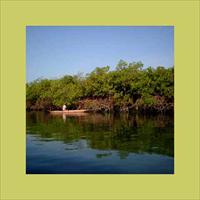SENEGAL: Protecting livelihoods through mangroves

Mangroves, one of the world’s richest ecosystems, are declining in Casamance, southern Senegal, and thinning forests spurred the Senegal-based non-profit Oceanium to plant six million mangrove trees in a bid to reverse deforestation, thereby boosting fish stocks and reviving livelihoods.
Up to 15,000 youths from 130 villages helped with the two-month replanting effort, just completed, which was the first of its kind in Africa, according to Binetou Diagne, Oceanium’s spokesperson.
One expert said it is critical to preserve mangroves. “Mangroves are one of the richest ecosystems in the world, and once they disappear water becomes very saline, and nothing can grow,” said John Eichelsheim, project manager of the local environmental non-profit, Intervene, Development, Ecology and Environment (IDEE-Casamance), which works to protect Casamance’s mangrove forests. “The more mangroves there are here, the more fish, shrimp and oysters there will be to eat and sell.”
Mangrove trees and shrubs, which grow in salty water on the edge of flooding rivers in tropical and sub-tropical zones, are home to rich sources of fish, shellfish and mollusks. In Casamance mangroves have created a fishing economy that supports thousands of locals, according to Bacary Sane, head of the regional fishing inspectorate in the regional capital Ziguinchor. Mangroves help control rising water levels and coastal erosion, and protect land from storm damage. They also provide a resting spot for many species of migrating birds.
“'The degradation of this ecosystem threatens the life and natural resources of Casamance,'' Oceanium’s Diagne told IRIN. “ The purpose of this project is to rehabilitate the mangrove ecosystem in Casamance, raise awareness about how to sustainably manage natural resources and restore the livelihoods of coastal Casamancais communities.”
Endangered
Mangroves are disappearing at a rate of 0.8 percent a year in Casamance, according to IDEE’s Eichelsheim, though he predicts that good rains this year will have slowed this rate. The UN Food and Agriculture Organization (FAO) estimates that mangroves are critically endangered or approaching extinction in 26 out of the 120 countries in which they are found.
Destruction of Casamance’s mangroves is caused primarily by the blockage of waterways by road-building, human encroachment on the forest, and cycles of drought affecting Casamance, Eichelsheim said.
Fishing official Sane said people also destroy mangroves by cutting them down at their roots when chopping firewood or searching for oysters.
Impact
Oysters, shrimp, tilapia, barracuda and catfish are among the many fish species that live in Casamancais mangrove forests, but now, Sane said, “You can only find big fish, as well as shrimps and oysters, but you can no longer find catfish or other varieties, while there used to be plenty.”
The depletion of fish stocks has particularly affected women who sell fish in bulk, according to Sadio Thioune, president of the local non-profit Group to Promote Women (GPF). “Women are closely involved in the fishing economy in this region. We sell fish, shrimp and oysters in the market and can earn up to US$20 a day from this, which greatly benefits our families,” she told IRIN. “Now it is difficult for fish-sellers in Ziguinchor markets to earn even US$4 a day because there is so little fish left to sell.”
Mariama Sonko, head of a local women’s group in Niaguis, 10km east of Ziguinchor, told IRIN the disappearance of mangroves harms other crops as well. Fewer mangroves mean the salt content of the water increases, which impedes the growth of paddy rice, she said. “When we plant the rice now, it doesn’t grow because there is so much salt in the water.”
More needed
Experts applaud Oceanium’s efforts and the attention the group has drawn to the problem of diminishing mangroves. But they say replanting on such a vast scale should be done slowly and in close conjunction with local communities.
Richard Dacosta, associate project director of the non-profit Wetlands International’s Mangrove Initiative for West Africa, said: “Reforestation must come after an in-depth analysis into why deforestation is happening in the first place. It is the second phase of a long process. And preparing populations to take part can take up to a year.”
Wetlands International – in conjunction with the non-profit International Union for Conservation of Nature, CARE, FAO and the UN Development Programme – is working to protect mangrove ecosystems in Senegal, Mauritania, Gambia, Guinea-Bissau, Guinea and Sierra Leone.
IDEE’s Eichelsheim warned that planting must not be rushed. Two types of mangroves grow in Casamance, he said – rhizophora racemosa and avicennia nitida. “Locals need to be very clear where and how to plant each, otherwise it risks damaging the ecosystem.”
Further, while the act of replanting can be seen as a solution, it generally takes between five and 10 years to see the true impact of a project, according to Dacosta.
Oceanium’s Diagne says they started raising awareness of the group’s project two years ago, in order to bring locals on board.
Eichelsheim said bringing about lasting change will require legislative reform. “For years and years we have cried out for mangroves to be protected by national laws [establishing] classified forests. The [Senegalese] government is now saying they ‘almost’ are, but making this ‘almost’ a reality is one of the most important things we need to do.”
 Back and Next - Back and Next
Back and Next - Back and Next See Also - See Also
See Also - See Also